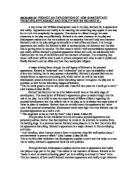Katherine Moore 0316
Exploration of the techniques used to foreshadow death in Richard _ III
Shakespeare’s tragedy of Richard III is a play where death is one of the central themes. It is therefore essential that Shakespeare makes this theme obvious to the audience even before characters die, and his primary way of doing this is through the foreshadowing of these deaths. He does this through dreams, language forms, imagery, curses, character and broken oaths. Due to these devices, the audience is already aware that certain characters will die, enabling Shakespeare to create dramatic irony. The context of the play is fundamental in ensuring that foreshadowing is taken seriously. Richard III would have been originally performed in front of an Elizabethan audience, an audience who would have believed that foreshadowing, both obvious and discreet, would have been extremely important. In addition they would have taken dreams, one of the principal devices that Shakespeare uses in Richard III to foreshadow death, very seriously.
Dreams in Richard III play a vital role in ensuring that the plot moves along, moreover they play a significant part in the foreshadowing of death. ‘So full of fearful dreams and ugly sights’ 1.4.3-4. Clarence’s dream in this scene is one of the more evident techniques Shakespeare uses to foreshadow death. Clarence interprets his death as being an accident, however, as the audience is very much aware of Richard’s true character, it becomes evident that it was not an accident at all. ‘What sights of ugly death within mine eyes; 1.4.23-24’. Shakespeare makes very obvious references to Clarence’s death in this dream, as well as using very morbid imagery, particularly of the sea, which strongly connotes the idea of drowning within the context of the dream. In addition throughout Clarence’s retelling of the dream, he uses words which are synonymous with death and pain; ‘drown’ ‘dreadful’ ‘fearful’ ‘gnawed’ ‘pain’ ‘dead men’. The use of these words aids Shakespeare in creating an ominous feeling which surrounds the character of Clarence. This ties in heavily with the context of the play, as an Elizabethan audience would have taken these signs seriously. This results in the audience becoming aware of Richard’s true character, creating successfully dramatic irony within the play.
Furthermore the audience is already aware by this point in the play that Clarence is likely to die in the play, as his death has been previously foreshadowed through that character of Richard, ‘Well your imprisonment shall not be long’ 1.1.114. Shakespeare has previously used Richard’s opening soliloquy to establish Richard as a character, so the audience is able to see the hidden meaning behind these words; that in fact his imprisonment shall not be long because he is going to die, not because he is going to be released. This succeeds in adding heavy irony to the play, as Clarence is very much unaware of the hidden meaning behind Richard’s words.
In addition to Clarence, Hastings is another character whose death is very much foreshadowed, primarily through the ‘loyalty plot’ set up by Richard. One of the first instances when it becomes evident that Hastings’ death is being foreshadowed is when he reveals his trust in Catesby, ‘And at the other is my good friend Catesby,’3.2.22. However the audience is very much aware by this point, due to the dramatic irony created by Shakespeare that Catesby is in fact plotting against Hastings, so the revelation of his trust in him is a very ominous sign for Hastings. Also, Hastings believes himself very much to be safe. ‘With some men think themselves as safe as thou am I’ 3.2.66-67. However as the audience is aware that Hastings is being trapped the line becomes extremely ironic, and Catesby’s previous line seems to confirm this, ‘Tis a vile thing to die, my gracious lord when men are unprepared and look not for it.’ 3.2.64. This introduces the irony into the situation, and this enables Hastings demise to be successfully foreshadowed. Also, Hastings’ death is foreshadowed more literally, ‘I’ll have this crown of mine cut from my shoulders before I’ll see the crown so misplaced.’ As the audience is aware that Richard does eventually become king, this oath prefigures the fate of Hastings, with the crown being a pun for Hastings’ head, (the crown of his head) and the royal crown, Hastings’ curse then comes true at the end of the play. Moreover, the dream by Stanley serves as a warning to Hastings ‘He dreamt the boar had razed off his helm.’ 3.2.11. The boar here is symbolic of Richard, although in its literal context this is neutral, this symbolism of Richard as a boar has been used throughout the play, particularly by the women, in a negative context, along with other bestial imagery used for Richard, ‘The tiger hath seized the gentle hind’ 2.4.53. This therefore results in the audience realising that when Richard is being compared to an animal, than it is in a negative sense, thus the audience realising that the dream cannot be dismissed. However Hastings dismisses this dream, not only subsequently foreshadowing his death in the sense that the dream needs to be taken seriously, but it is effective, as it serves to show to the audience that Hastings is blind to Richard’s villainous behaviour, and he therefore will not be watching out for Richard.







